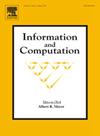The longest subsequence-duplicated subsequence and related problems
IF 1
4区 计算机科学
Q3 COMPUTER SCIENCE, THEORY & METHODS
引用次数: 0
Abstract
Motivated by computing duplication patterns in sequences, a new fundamental problem called the longest subsequence-duplicated subsequence (LSDS) is proposed. Given a sequence S of length n, a subsequence-duplicated subsequence is a subsequence of S in the form of with being a subsequence of S, and for all i in and j in . We first present an time algorithm to compute the longest cubic subsequences of all the substrings of S, improving the trivial bound. Then, an time algorithm for computing the longest subsequence-duplicated subsequence (LSDS) of S is obtained. Finally we focus on two variants of this problem. We first consider the constrained version when Σ is unbounded, each letter appears in S at most d times and all the letters in Σ must appear in the solution. We show that the problem is NP-hard for , via a reduction from a special version of SAT (which is obtained from 3-COLORING). We then show that when each letter appears in S at most times, then the problem is solvable in time.
最长子序列-重复子序列及其相关问题
基于序列中重复模式的计算,提出了一个新的基本问题——最长子序列-重复子序列。给定长度为n的序列S,子序列重复子序列是S的x1d1x2d2⋯xkdk形式的子序列,其中xi是S的子序列,对于所有i in [k]和j in [k−1],xj≠xj+1和di≥2。我们首先提出了一个O(n6)时间算法来计算S的所有O(n2)子串的最长三次子序列,改进了平凡的O(n7)界。然后,给出了计算S的最长子序列重复子序列(LSDS)的O(n6)时间算法。最后,我们关注这个问题的两个变体。我们首先考虑约束版本,当Σ无界时,每个字母在S中最多出现d次,并且Σ中的所有字母必须出现在解中。我们表明,问题是np困难的d=4,通过从一个特殊版本的SAT(这是由3-COLORING)。然后我们证明,当每个字母在S中最多出现d=3次时,那么问题在O(n4)时间内可解。
本文章由计算机程序翻译,如有差异,请以英文原文为准。
求助全文
约1分钟内获得全文
求助全文
来源期刊

Information and Computation
工程技术-计算机:理论方法
CiteScore
2.30
自引率
0.00%
发文量
119
审稿时长
140 days
期刊介绍:
Information and Computation welcomes original papers in all areas of theoretical computer science and computational applications of information theory. Survey articles of exceptional quality will also be considered. Particularly welcome are papers contributing new results in active theoretical areas such as
-Biological computation and computational biology-
Computational complexity-
Computer theorem-proving-
Concurrency and distributed process theory-
Cryptographic theory-
Data base theory-
Decision problems in logic-
Design and analysis of algorithms-
Discrete optimization and mathematical programming-
Inductive inference and learning theory-
Logic & constraint programming-
Program verification & model checking-
Probabilistic & Quantum computation-
Semantics of programming languages-
Symbolic computation, lambda calculus, and rewriting systems-
Types and typechecking
 求助内容:
求助内容: 应助结果提醒方式:
应助结果提醒方式:


